Films in which NUDITY and SEX make actual sense
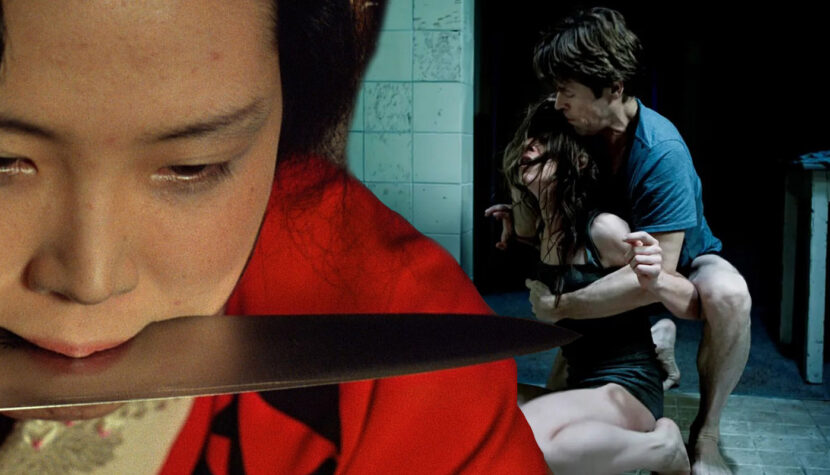
Unfortunately, sex and nudity on the screen is often a cheap gimmick, which adds absolutely nothing to the message of the film or its content. Below, however, I would like to present to you a few glorious – in my humble opinion – exceptions in which these elements were introduced for a specific purpose and without which the said films would lose a lot of their power. Films in which nudity is not only an attempt to attract the viewer to the cinema for a “piece of naked body”, but a procedure that only emphasizes what the creators wanted to convey, tell or visualize. And without trying to be CHEAP (because this is the word that needs to be emphasized), controversy – although there will be plenty of films considered controversial in this list.
In the Realm of the Senses (1976) dir. Nagisa Oshima
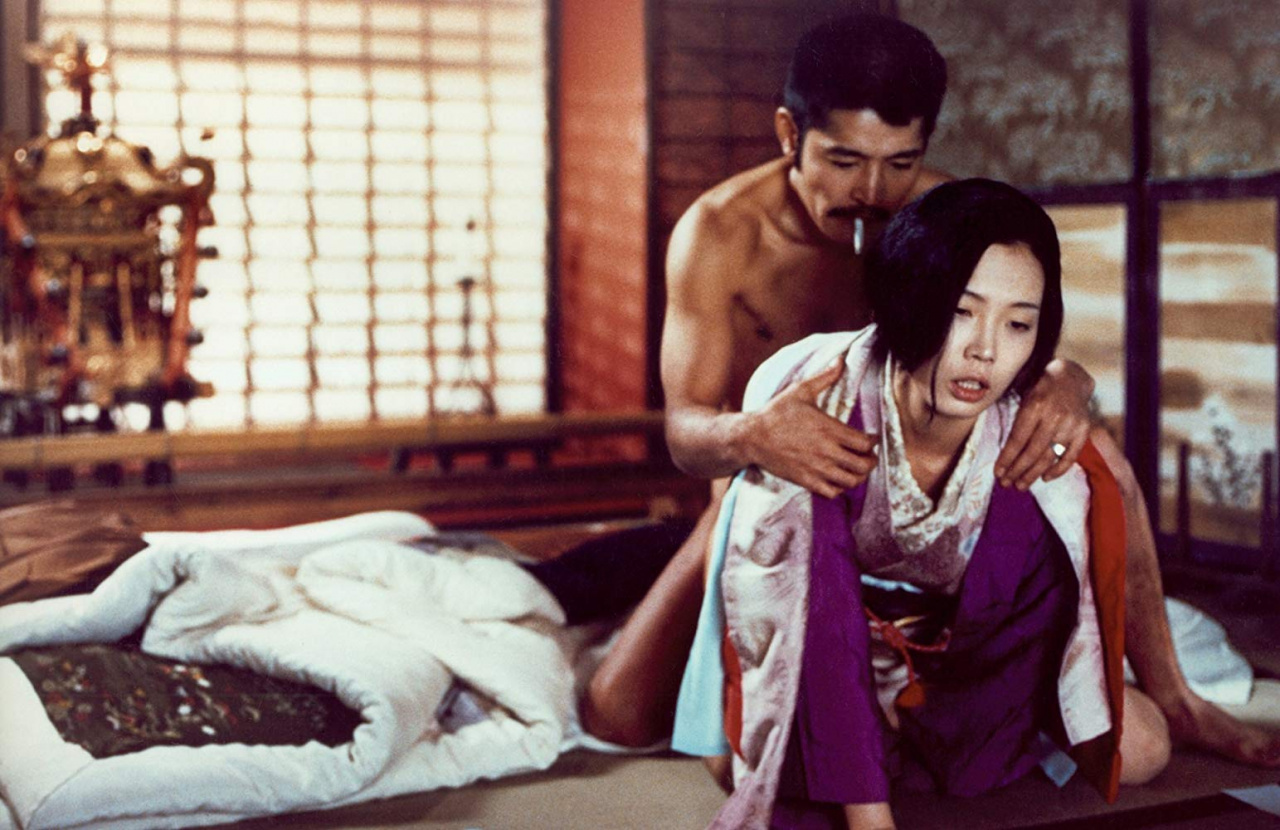
And we will start this ranking with a bang, because with the amazing work In the Realm of the Senses directed by Nagisa Oshima. But before we get to the plot of this erotic film based on true events, let’s stop for a moment for the director. Oshima was offered to make this film by the French producer Anatole Dauman, and he gladly agreed to the cooperation. What drove him? First, because of the times and customs, he couldn’t have made this film in Japan. Let’s not kid ourselves – what the Japanese director showed in his melodrama has so far been present only in the porn industry. And since Oshima had a clear desire and talent to pave these paths in cinematography, it was quite a good thing that the cooperation of both men came to fruition. For those who have already had the undoubted pleasure of watching In the Realm of the Senses, it will come as no surprise that Oshima has been called a scandalist. But I assure you now (and I’ll prove it in a moment) that his manifesto of erotic cinema, unlike many films, makes a lot of sense, and the almost pornographic scenes are completely justified. If I wanted to summarize the plot to a minimum, I could write that it is the story of Sada Abe (Eiko Matsuda) who works in a hotel as an escort and her lover, although married to another woman, the rich man Kichizo (Tatsuya Fuji). But to say that there was love between them is to say nothing. First of all, it was mainly carnal love. And here we have the first argument to justify the blunt showing of nudity in this film. Could the erotic scenes be shot differently, so that the camera would not film the genitals of these two in such a greedy way? NO. In this case it is not possible.
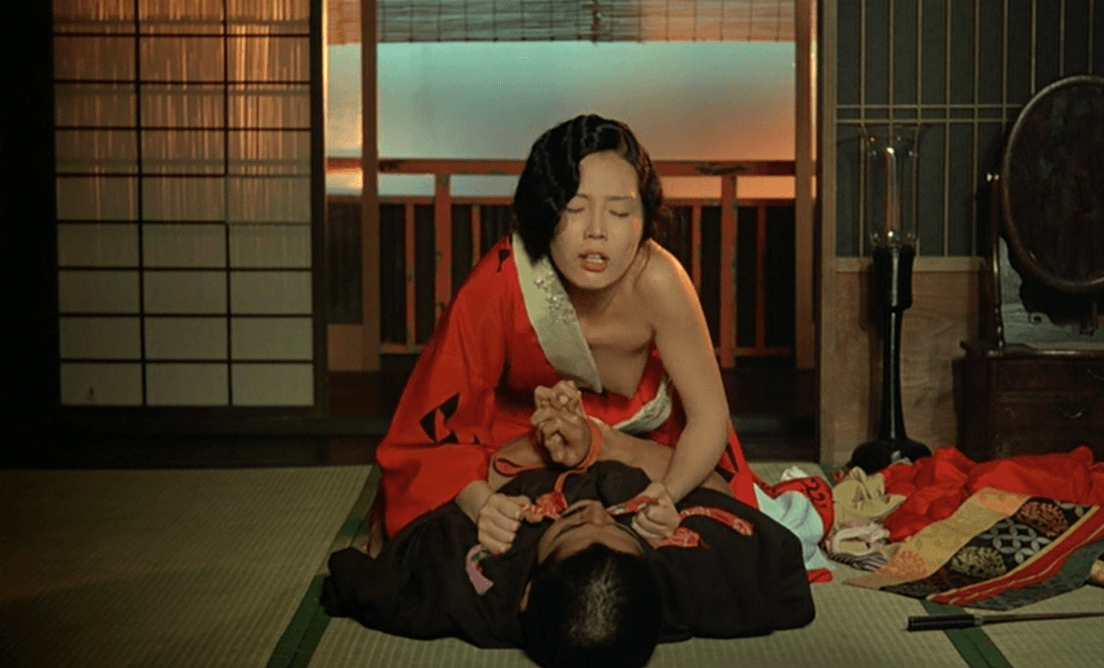
We have an obsession movie here. Kichizo’s penis is like a magical totem for Sada, and sex, especially oral, is a kind of ritual for her, leading her to excitement and the only possible complete happiness. Could it have been filmed so that the camera showed something else during their sex? Again – no. This film was not intended by the creators to be mysterious and romantic. And despite these, let’s call it openly, pornographic images, thanks to its plot and excellent music, Minoru Miki still remains sensual and beautiful. I have the impression that sometimes we focus so much on Sada and Kichizo’s conversations that we completely forget about their nakedness. The feeling between Sada and Kichizo develops slowly. They are both fascinated by each other. He praises her beauty, she infuses with the scent of his body and the texture of his skin. In the beginning, he is the one who directs her when she gets aroused too quickly and too intensely. However, these roles change very quickly and she turns out to be the dominatrix here (actually a switch, but more on that later). From passionate, gentle sex, we move on to typical BDSM games. So there will be an element of pissing, bonding, pinching or beating. It is also important that in most sexual relations between them, she is on top. And it will be Sada who will generally dominate her sex slave in this, although as I have already made it clear, she was not a 100% dominatrix. Because when she meets her client, she begins to feel the need to be humiliated, thus asking him to beat her and not feel sorry for her.

But let’s get back to the feeling between Sada and Kichizo now. Was it only physical? Probably not though. Notice the jealousy between them. On the one hand, he wanted her to earn money by working her body, on the other, he couldn’t stand the thought of anyone else touching her. She initially agrees to let him see the geisha in her absence, only to threaten him with death and castration some time later. Then, in turn, she almost forces him to have intercourse with a seventy-year-old woman (here too nudity is justified, because we have to show the abomination of this act and only a blunt depiction of it can affect the viewer). Sada is therefore unpredictable. But not just because she changes her mind every now and then, or because she loves to make love when someone witnesses it, or because the line between orgasm and murder is a fine line with her. Sada is afraid of losing her beloved, and on the other hand, when suffocating, she knows no mercy. We can also approach them in a completely different way. Sada’s lewd behavior may also be selfish. Because doesn’t she treat her partner a bit like an object? Let’s continue on this track. Can’t we consider Sada a mentally ill person, a sadist who knows no moderation and lives for her own pleasure? Or is he suffering from some kind of disorder? Sam notices that his penis obeys her, and he is devoted to her like no other. Isn’t it therefore justified to show the penis when everything revolves around it? It is, and it is. We can also not look at the film with indignation, but see that Oshima reveals to us the beauty that has so far been forbidden in the cinema.
Possession (1981) dir. Andrzej Żuławski
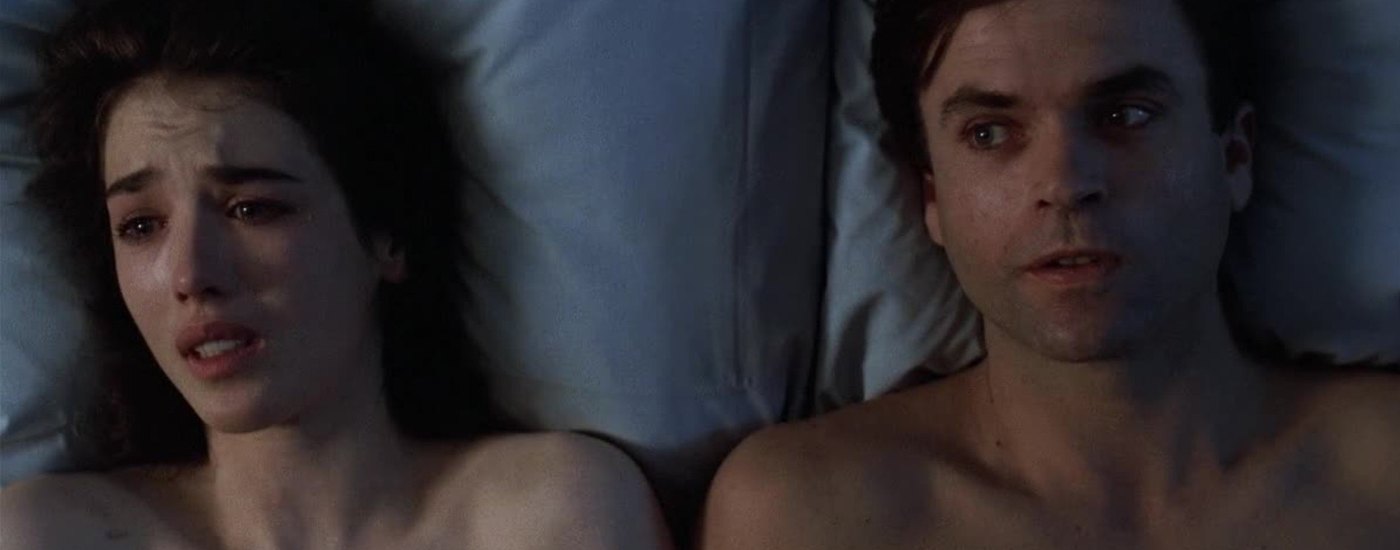
Żuławski’s film is a moving story about the breakdown of a marriage. From the very beginning, it is saturated with negative emotions, stormy quarrels and even physical violence. We see love battling selfishness and indifference, remnants of drive and desire battling resentment and frustration. The spouses are engaged in a war of mutual accusations and a game of lies, and there is no indication that an agreement is to be reached between them. And we, the viewers, are brutally drawn into this whirlpool of feelings, which the further into the forest, the more elements of horror, macabre or horror will be there.
The woman (Isabelle Adjani) has a dual personality. She is delicate, subtle, sensitive and caring, but also passionate, full of passion and desire. Her husband (Sam Neill) fails at every turn, especially in marriage. What’s worse, he can’t find an answer to the question why this is happening. He does not understand the world around him and the events that affect him. A woman’s lover, on the other hand, is an incredibly self-confident character.
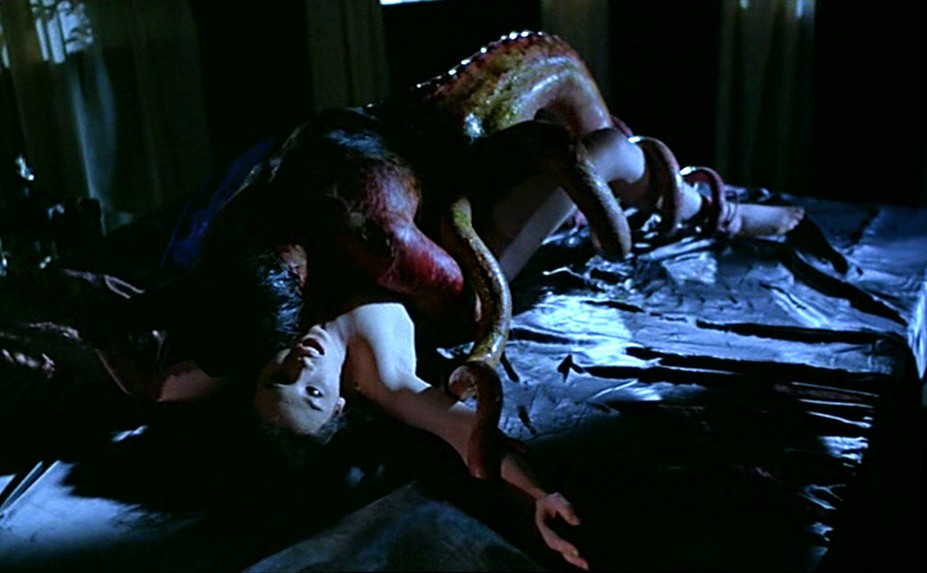 In one of the scenes of the film, Mark returns home to find it in a state he did not expect at all. His wife does not take care of the child, who is completely neglected, instead she is lost in thought and it seems that her soul is in a completely different place than her body at the moment. She quickly admits to her husband that she has a lover, Heinrich (Heinz Bennent), but there is something else she is hiding from him. Mark, unable to come to terms with the situation and not wanting the marriage to break up, decides to hire a private detective who very quickly discovers the woman’s terrifying and dark secret. She maintains an intimate relationship with an octopus-like monster, the beast. Why does a woman decide to take this step? Maybe because her husband doesn’t meet her sexual expectations. Maybe because it doesn’t meet them at all. And she needs someone who will possess her, who will dominate her. Someone strong, not to say physically superior to her. Therefore, her frustration and lust take on inhuman proportions. But the monster from Żuławski’s film can be interpreted in many ways. We can approach the subject a bit more metaphorically and treat the beast as a visualization of growing hatred between spouses. We can interpret it in a hundred different ways, but the important thing is that showing the sexual intercourse of a naked woman with a monster is completely justified. I guess that one of Żuławski’s goals was to shock the viewer, and I think he succeeded. But it’s not just about shocking. The scene of intercourse with the monster, by filming it directly and through its nudity, shows the disharmony between the beautiful body of a delicate woman who wants to be enslaved and the disgusting body and terrifying shapes of the beast. In addition, it is worth noting the almost theatrical and exaggerated acting, which makes this scene even more meaningful. A woman who until now seemed lost and depressed now seems to be the one who has achieved full satisfaction and happiness.
In one of the scenes of the film, Mark returns home to find it in a state he did not expect at all. His wife does not take care of the child, who is completely neglected, instead she is lost in thought and it seems that her soul is in a completely different place than her body at the moment. She quickly admits to her husband that she has a lover, Heinrich (Heinz Bennent), but there is something else she is hiding from him. Mark, unable to come to terms with the situation and not wanting the marriage to break up, decides to hire a private detective who very quickly discovers the woman’s terrifying and dark secret. She maintains an intimate relationship with an octopus-like monster, the beast. Why does a woman decide to take this step? Maybe because her husband doesn’t meet her sexual expectations. Maybe because it doesn’t meet them at all. And she needs someone who will possess her, who will dominate her. Someone strong, not to say physically superior to her. Therefore, her frustration and lust take on inhuman proportions. But the monster from Żuławski’s film can be interpreted in many ways. We can approach the subject a bit more metaphorically and treat the beast as a visualization of growing hatred between spouses. We can interpret it in a hundred different ways, but the important thing is that showing the sexual intercourse of a naked woman with a monster is completely justified. I guess that one of Żuławski’s goals was to shock the viewer, and I think he succeeded. But it’s not just about shocking. The scene of intercourse with the monster, by filming it directly and through its nudity, shows the disharmony between the beautiful body of a delicate woman who wants to be enslaved and the disgusting body and terrifying shapes of the beast. In addition, it is worth noting the almost theatrical and exaggerated acting, which makes this scene even more meaningful. A woman who until now seemed lost and depressed now seems to be the one who has achieved full satisfaction and happiness.
The Golden Glove (2019) dir. Fatih Akin
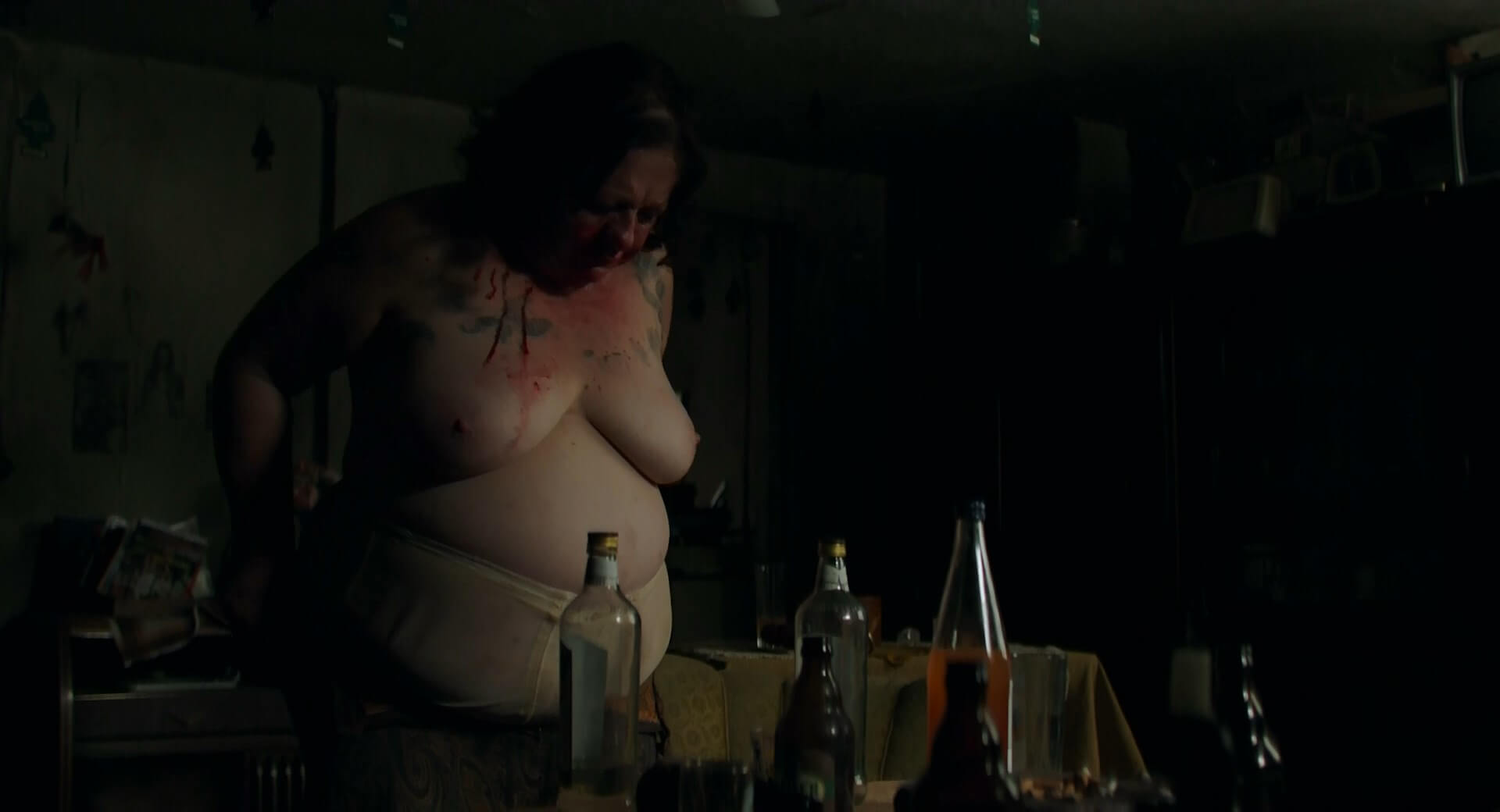
How lucky it is that you can’t convey the smell to the viewer through the screen – I thought after watching Fatih Akin’s film full of nudity of the living and the dead. The ubiquitous ugliness, carnality, dingy places and degenerated characters overwhelmed me so much that the mere thought that I would still smell the stench of the main character’s apartment Fritz Honka (Jonas Dassler) makes me shudder with disgust.
The Golden Glove owes its name to a bar in Hamburg that still exists today. This place does not look like in the seventies, when it was a gathering of all kinds of social outcasts. Time was spent there by alcoholics, devastated by life, devoid of ambition, people with shady war pasts and elderly prostitutes who allowed themselves to do literally anything with each other.
The most important figure was the aforementioned Honka. An unremarkable, sadistic serial killer would come to The Golden Glove to drink a few schnapps and find his next victim. And the women who stayed there, often homeless, were intoxicated with alcohol. Inspired by real events and Strunek’s novel, Akin created an incredible character. It’s not just the director.
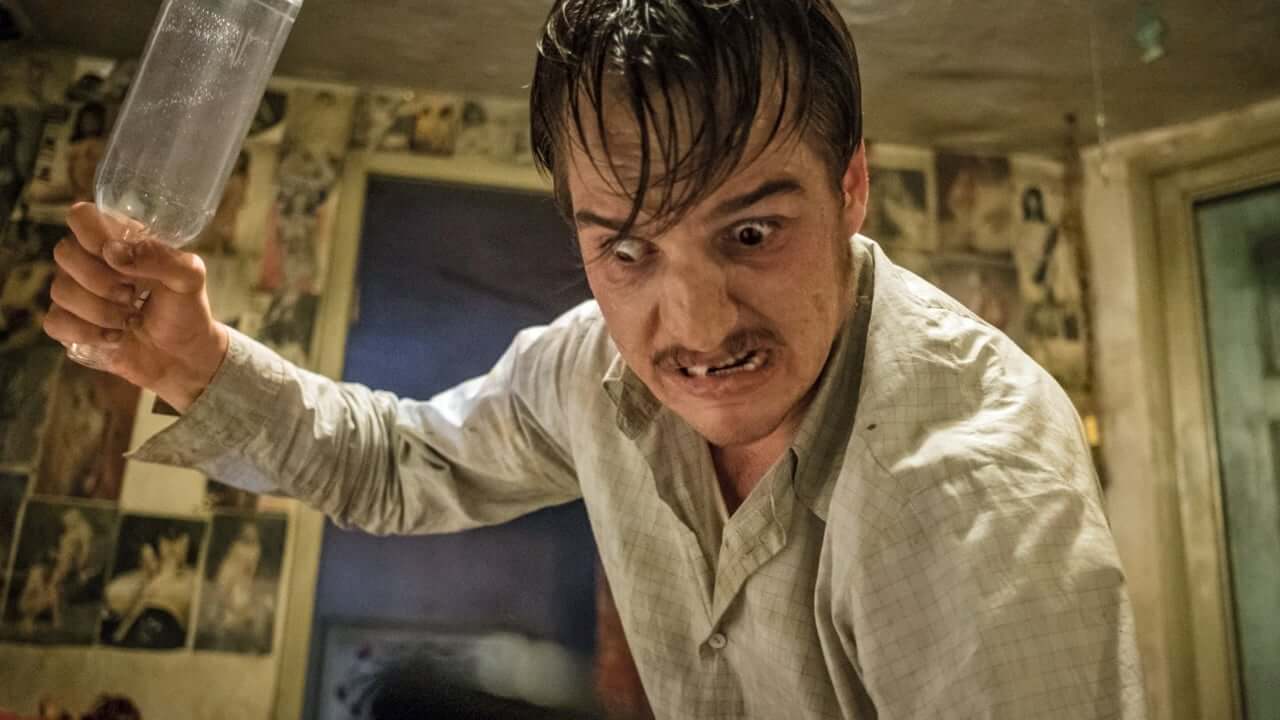
Kudos are also due to the young Dassler, whom we have seen so far in completely different roles – handsome men with a swashbuckling twinkle in their eyes. He got into Honka’s character flawlessly. He is disgusting both in appearance (applause for the make-up artists) and behavior. Dassler’s every move is a perfect representation of Honka’s attitude. And here, too, nudity plays an important role. Regardless of whether he rapes another prostitute half-dressed after erection problems, or ineptly dismembers her body to the rhythm of German hits and with a bottle of vodka in his hand, or simply walks around his dingy apartment. In every move, word and gesture he is hideous to the limit. And Akin loves this abomination, loves to show naked flesh and blood and cares little if the viewer likes it. Is it shocking? NO. It’s not a gore movie – it’s not Tarantino, Trier or Mikke. The director did not want to show the celebrity, as Berlinger did in the film about Bundy’s crimes – Extremely Wicked, Shockingly Evil and Vile. Honka is also not an intellectual like Jack Unterweger, an Austrian serial killer, the anti-hero of the film directed by Elisabeth Scharang.
Akin’s film is brutal and naturalistic, comparable to the aesthetics of Ulrich Seidel’s films. It doesn’t take a few minutes to strangle a woman. It requires strength and patience. And the decaying corpses buried in the walls cause vomiting. This is the brutal reality. But the camera doesn’t show everything directly. Setting it up in multiple scenes is a topic for a really separate discussion. Let me just mention one scene here. Honka cuts off the head of a naked woman. We see a disgusting room on the screen, a naked corpse lying on the floor and huge amounts of blood, we hear the sounds of cutting the body (and German hits), but we do not see the victim’s head or Honka himself performing this brutal act. The scene is suggestive enough to make us almost vomit, and yet shown not entirely directly – what makes it different from gore cinema, for example.
Critics did not like the film. Certainly not just because of completely sexually unattractive nudity. Voices of indignation could also be heard from the viewers, with which I cannot agree at all. Apart from the legitimate display of the naked human body, Akin deserves credit for moving away from a cinema full of Turkish themes, which, while brilliant, somehow limited him. With The Golden Glove, he proved that he can find himself in a variety of genres. He also proved that nudity in the cinema does not always have to be exciting, stunning and beautiful.
Punish me / Verfolgt (2006) dir. Angelina Maccarone
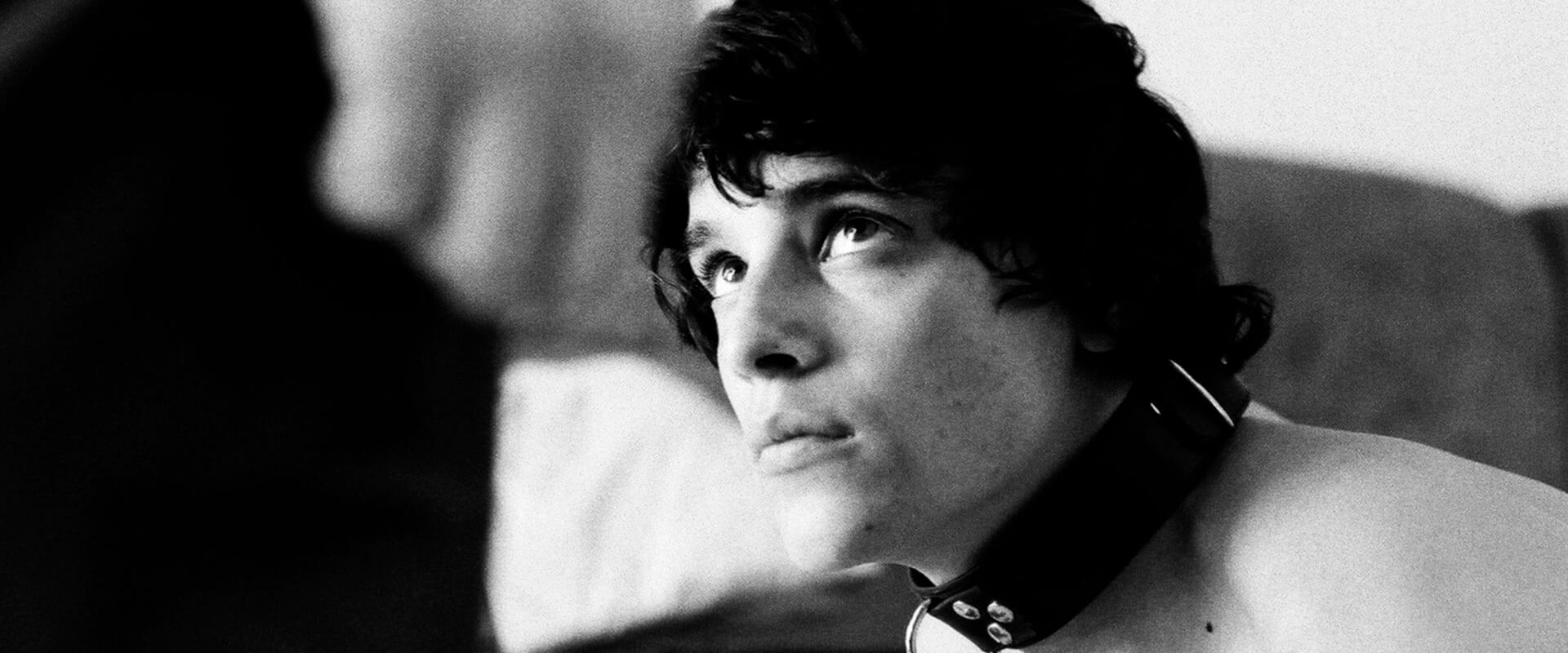
The next film on my list is about a beautiful sadomasochistic relationship between fifty-year-old curator Elsa (Maren Kroymann) and her ward – young, delicate, almost girlish Jan Winkler (Kostja Ullmann).
We encounter nudity (mainly male this time) in this drama from the first scene, in which a battered Jan in the shower, touching his naked body, begins to discover that pain gives him pleasure.
In the following scenes, we can observe how the relationship between the woman and the boy (because he is certainly far from being a man) develops, how her dominance and his submissiveness develop. The woman does have a husband (Markus Voellenklee), but he has cheated on her and there is no longer the chemistry between them, which may have been in the past, and she cannot forget about this betrayal. The director Angelina Maccarone emphasizes in her film that a woman needs to be adored regardless of age.
But the relationship between the two main characters develops gradually. Jan starts following Elsa. He discovers her address and obtains her phone number. And although the woman initially pretends to be annoyed and unhappy about the situation, the fact that Jan is focusing all his attention on her is very flattering. And how the boy is greedy in his lust, how much he knows what he wants (he wants to be her slave), how desperate and ready for anything he is, we see in almost every scene when these two are together. In the scene where Jan keeps a close eye on Elsa while driving together, during lessons where he purposely stays after work to talk to her, and in the scene where he goes to dinner with her husband after work. Jan pushes his limits, but Elsie seems to enjoy it and isn’t going to stop him.
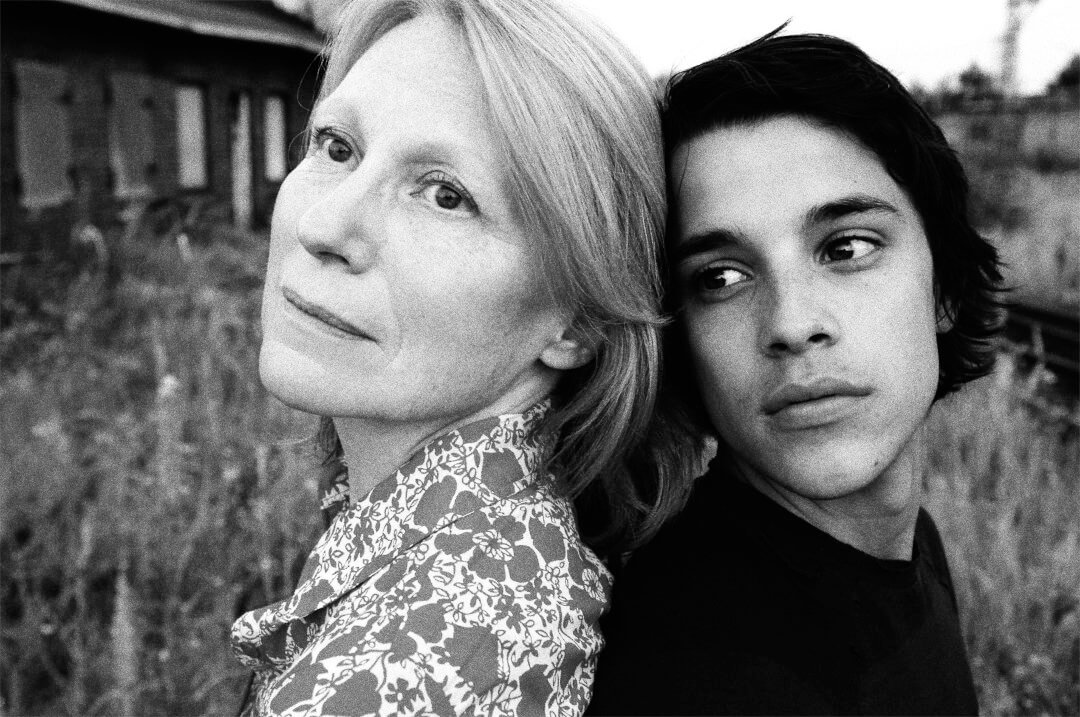
At first, she is not ready for physical domination yet, so she decides to humiliate the boy in another way, namely, she begins to make love to her husband in front of him (knowing that Jan is watching them). Perhaps this is one of the few reasons why she decides to have sex with her husband.
The great advantage of this film is the extraordinary sense and skill of the director in building tension. We have to wait quite a long time for the scene of the first meeting. But when we wait, we get pure beauty. These two learn from each other. When Elsa finally decides to meet Jan she begins to slowly order him around, on the other hand, she is not entirely sure what she should do with him or what she should order him. It is he who, with a swashbuckling look, instructs her that she should know what she wants. Everything develops slowly. slowly. No rush. There is a lot of eroticism in it, but it is dosed in small portions. The woman tells him to approach her, to undress to her underwear. She slaps him. She tugs at her hair. Spanking.
And that’s it. Oh no! The viewer will not see sex scenes here, although Maccarone realizes that he is looking forward to it. Just like John is waiting for it. In the next meeting scenes, we will have more humiliation, more beatings that Jan himself begins to ask for, more bondage, more domination, submission and everything that BDSM lovers love the most. And it should be added here that as for this subject, this film remains very subtle. It is difficult to say whether the feeling between Jan and Elsa can be called love, but one thing is certain – they are both addicted to each other, they both want each other, and it is not even about intercourse anymore, but about the master-slave relationship.
But let’s answer the question – was nudity necessary in this film? And as you may have guessed, I would say yes. The camera shows the viewer what they see because they want to see, Elsa’s eyes. And Elsa’s eyes see her servant in all her glory. They see his naked body in every detail (although the play of light and shadow effectively obscures some elements). Showing Jan’s nakedness, his young, slim, boyish body is intended to completely expose the corporeality, but also the soul of the sexual slave.
Antichrist (2009), dir. Lars von Trier

I have a huge problem with von Trier’s Antichrist, and not because I don’t know how to prove that nudity in this drama was necessary, but because for me this film is an absolute work about which you can write scientific papers and analyze it in hundreds different ways. However, I will try to limit myself to the topic of my choice, which will certainly be very difficult.
The film begins with a black and white, almost dreamlike sex scene between the two main characters. While they get carried away by their emotions, their little son gets out of the crib, climbs onto the window and falls out. The question I want to ask here is: was it really necessary in this scene of the act of intercourse to show the man’s penis penetrating the woman? Yes, it was. The penis is a kind of evil symbol here. It was he who gave the woman a pernicious pleasure that was so strong that the woman forgot about the world around her. The scene had to be so eloquent as to emphasize the opposition between the pleasure taking place in one room and the tragedy taking place next door.
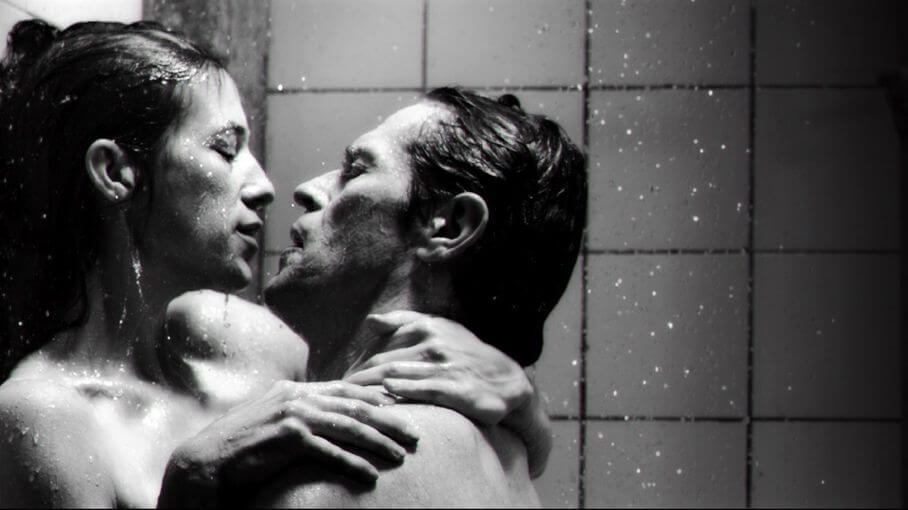
Trier’s film cannot be read unequivocally. It is full of symbolism. It tells about human fears that cannot be clearly explained. The film, despite the blunt opening scene, is not about pure sexuality, but it certainly has a fight between femininity and masculinity. This is a film about surrendering to the chaos of your mind. But it is also a film about opposites – about a woman and a man, about desire and rejection, about nature and civilization, about madness and peace, and finally about life and death. This is a film that not only affects the viewer with brutal images and corporeality, not only wants to shock (although this was certainly one of von Trier’s intentions), it is a film that, through its bluntness and multilayeredness, is supposed to force the viewer to think for himself, influence the state of his mind.
In Antichrist, we observe the heroine’s trauma and life experience that touches her husband, who wants to work through this problem with her. But it’s not just about the trauma of the death of a child. The question is how it happened and whose fault it was. Because when the boy hits the ground, his parents are having an orgasm in the next room. Therefore, it is not just trauma after losing a child, but a constant feeling of guilt and experiencing punishment for the pleasure that this time turned out to be disastrous.
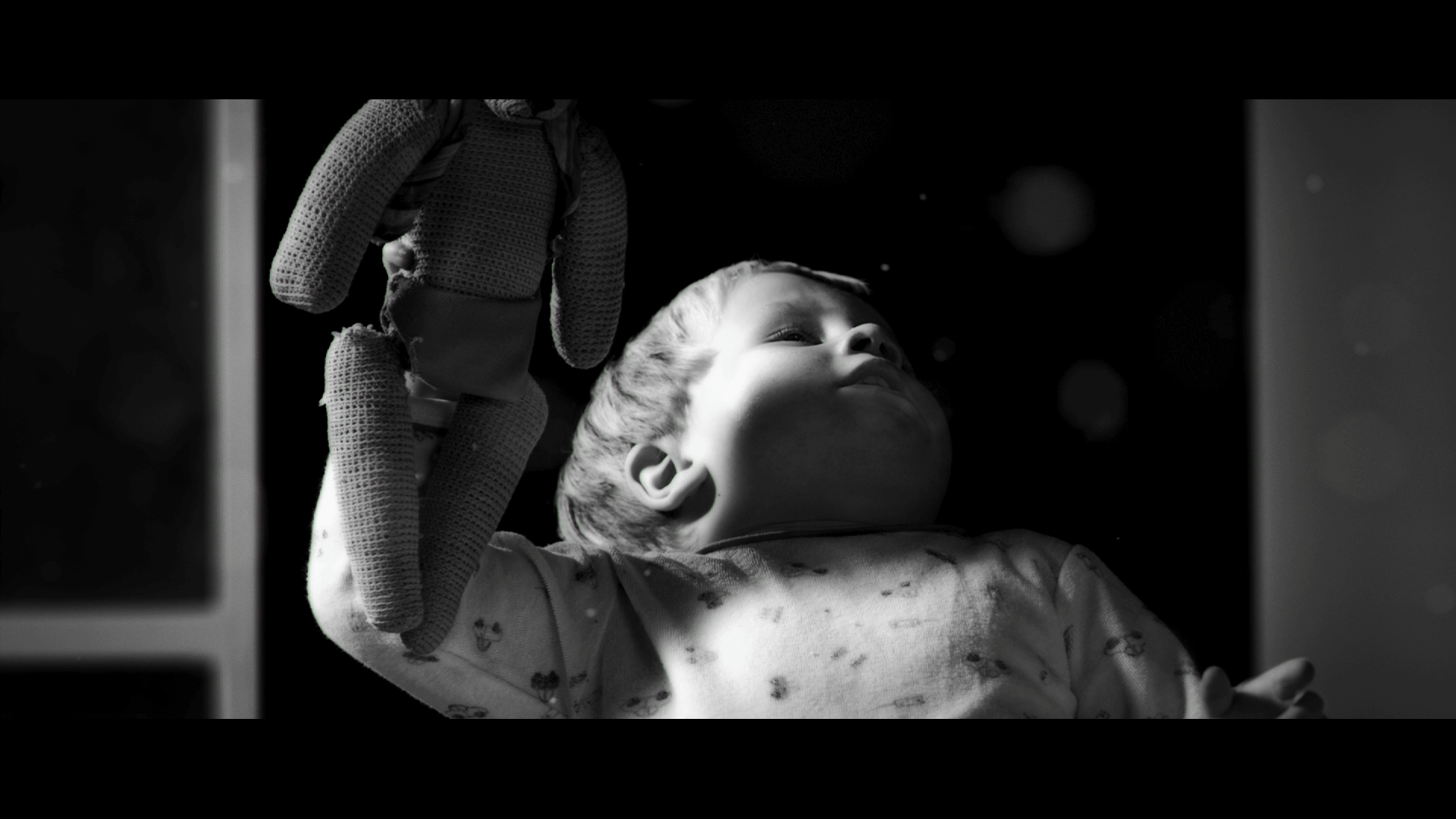
The most drastic of the scenes is, of course, the one in which the woman cuts off her clitoris. Was it necessary to show it? I think so. The woman throughout the film, step by step, falls into madness, which is the climax of this act. We can read the clitoris cutting in many ways, for me it is a kind of punishment that the woman imposed on herself, it is a punishment for her that when her child was in danger, she selfishly thought only of her own pleasure. The director had to show this scene directly to make the viewer aware of the state of the woman’s mind. The growing madness and trauma in her made her ready to commit such a brutal act. And we could see all this brutality with our own eyes. Many viewers and critics believe that what Trier showed on the screen crossed certain boundaries. I think everyone will remain subjective here. For some, this scene will be shocking, others will watch it without unnecessary convulsions of fear and disgust. I certainly disagree with the outraged feminist movement that Trier abuses and humiliates women. As a woman, I completely misinterpreted both the castration scene and the Danish director’s entire film.
Fat Girl (2001) dir. Catherine Breillat
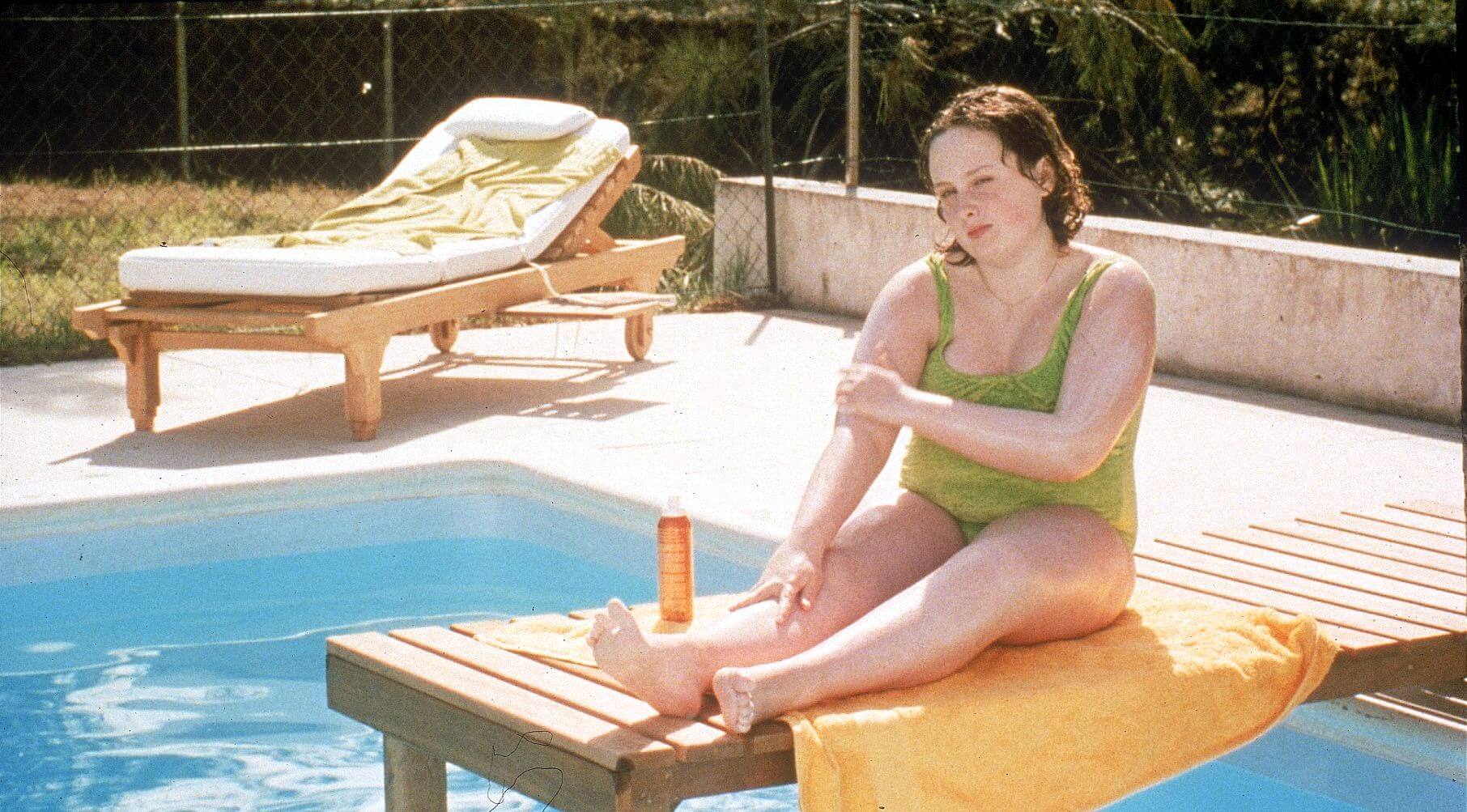
Living on the outskirts of Paris, a family consisting of the parents (Arsinée Khanjian and Romain Goupil) of fifteen-year-old Elena (Roxane Mesquida) and younger Anaïs (Anaïs Reboux) spend their holidays in the countryside. Sisters are the opposite of each other. Elena is slim and self-confident, Anaïs is obese and smothered by everyone, craving attention. Father and mother are completely unable to cope with parenthood. They do not notice that their younger daughter has a problem with eating disorders, which makes her obese, which is dangerous for her health. They believe that the problem lies in hormonal disorders, and the huge portions put on the plate by the girl are not a problem for them. But not only the aspect of improper nutrition is important here. When Anaïs cries at the breakfast table, her mother blames it on her adolescence, and her impatient father just wants it to pass as soon as possible.
The girls also spend time together. During one of the walks, they go to a nearby bar to drink something cool. They are invited to the table by a young boy and this is how Elena meets an older Italian law student, Fernando (Libero de Rienzo). After a few minutes of talking, they start kissing, oblivious to the presence of Anaïs, who is eating ice cream. Elena gives the impression of self-confidence, having experience in conquering men’s hearts.
Elena also very quickly invites Fernend to her bedroom at night, regardless of the fact that her parents are sleeping next door, even her sister sleeping in the next bed.
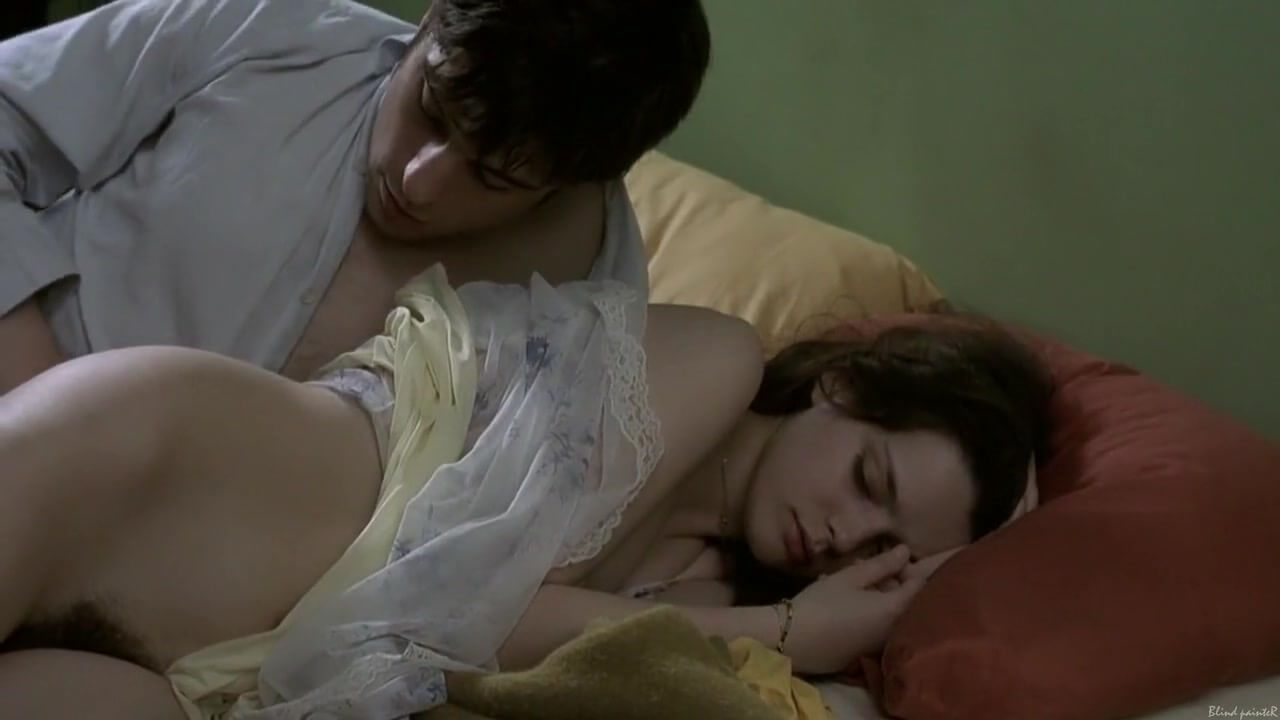
The boy and the girl slowly start to caress each other. Elena reveals her breasts, but nudity will not be an omen of action here. Quite the opposite. And the girl turns out to be not as experienced as she posed at the beginning. Although they are seconds away from having sex, Elena begins to hesitate and prolong the situation. On the one hand, she reveals her breasts and allows herself to be touched on them, on the other, she starts asking the boy about how many girls he has slept with before her and if he loves someone, he sleeps with others. Fernando, despite telling the inexperienced teenager everything she wants to hear that will lead him to sex, starts to lose his patience. The camera suddenly shows us Anaïs lying next to her. The girl is not sleeping. He sees his sister already undressed, sees her naked womb and Fernando’s penis ready for action. Showing the penis in this scene is justified because it shows the readiness of the man, so much different from the state in which Elena is at the moment. She keeps procrastinating. He still wants to talk. She still prevents him from deflowering her, she is still not like a mature woman ready for this deed, but like a little girl who found herself in the wrong place at the wrong time. And that contrast is what gives this scene meaning. On the one hand, we have a woman’s body fully ready to give herself to a man, on the other hand, we see the girl’s still childish face, covered with make-up. And we have this terrible hesitation. I believe that the film directed by Catherine Breillat is not at all about the hardships of growing up. It’s an immature drama. Elena, who is ready to show the most intimate element of her body, is immature, but is not ready for intercourse, she does not even fully trust her partner and probably does not fully know what love is, Fernando is immature, who strives to have sex with a minor, and immature is Anaïs, who watches all this from the sidelines and does not oppose her.

Nudity in this film can also be read as a provocation. But is Elena deliberately provoking the student? Does he realize how her naked body affects him? I don’t think so. Nudity is therefore symbolic and ambiguous in this film. And the director deserves kudos for the fact that she also decided to show the male genitals. Unfortunately, in most movies only women are exposed, which is not entirely fair.
Paradise: Love (2012) dir. Ulrich Seidl

The problem of prostitution among women is taken up by directors very often. Ulrich Seidl, on the other hand, decided to focus on prostitution among men from Kenya who give themselves to rich women from the country of the director, i.e. Austria, called sugar moms. But before I get to the issue of prostitution and nudity, it’s impossible not to mention the intimidating issue of racism that Seidl shows us.
Not only are Kenyans serving tourists, but there is also a line between the hotel and the beach that defines its borders, which black souvenir sellers cannot cross. So they stand and wait until one of the sunbathing tourists decides to go to the sea, thus crossing this border. The main character (Margarete Tiesel) is kind to the Kenyans at first. He patiently endures their intrusiveness and even buys unnecessary souvenirs. However, in another scene, where she and her friend are trying to teach a black bartender a few phrases in German, and he is not very good at them, they start mocking him and commenting that he is not very smart. In the same way, they have no problem commenting on the body and appearance of other Kenyans. And although they say that they are so exotic and their skin smells like coconut, on the other hand, they say that they cannot tell them apart. But the most important goal is sugar mom. They come to a resort in Kenya to taste sex with local men. I don’t see a problem with the age difference. Teresa initially thinks the idea is ridiculous and crazy, but soon meets up with one of the Kenyans in a dingy room. They are both naked, and although the woman is far from perfect, the man treats her like a queen. She knows exactly what she lacks. As we can learn from conversations between friends, women are neglected by their husbands. They have numerous complexes, they are ashamed to undress and show their husbands, so they look for intimacy elsewhere.
Teresa, although she decided to take this step, quickly resigns, because she does not feel comfortable.
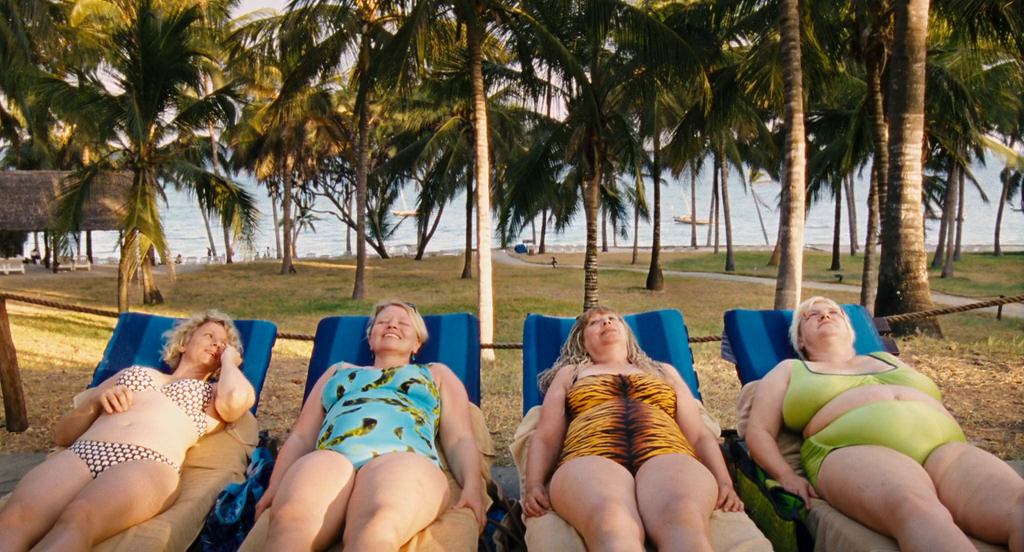
But it doesn’t take long before she meets another Kenyan. This one is not that squishy compared to the others. After spending time together and going for walks, during which he keeps saying how much he likes Teresa and how he doesn’t want money, but only love, they end up in a man’s tiny flat. After drinking coconut wine and smoking a joint, Mung (Peter Kazungu) begins ineptly touching Teresa. His behavior makes her laugh instead of excited. A woman must teach him how to touch her body properly, how to kiss her, and how to look her in the eye. The cheerful atmosphere is conducive to the fact that Teresa begins to open up.

Here, too, applause for the actress, who not only agreed to nude scenes, but was able to joke about her shortcomings. A woman, sitting naked in front of her much younger and beautiful lover, talks about her overweight or sagging breasts. However, the fact that she found herself in such a situation proves that she is still looking for acceptance and intimacy, which she probably no longer receives from her husband. A woman also wants love. And although he treats the repeating “I love you” by the Kenyan with great distance, knowing that these are just empty, meaningless words, he receives at least a substitute of feeling in this way.
I am convinced that showing nudity in Ulrich Seidl’s film was absolutely necessary, and the director approached it with the greatest respect, teaching us that in fact each of us is beautiful in our own way and should be appreciated.
Salò, or 120 Days of Sodom (1975), reż. Pier Paolo Pasolini

In the last place of this list I decided to put one of my favorite films, which is Salò, or the 120 Days of Sodom, belonging to the so-called Trilogy of Death by the brilliant Italian director Pier Paolo Pasolini. This is the last film of the master, based on the novel by Marquis de Sade. The action of the film is moved from France to the fascist republic of Salò in 1944–1945. It was first screened in November 1975 in France, but was banned in Italy at the time because of its sexual content.
Four fascist dignitaries: a bishop (Giorgio Cataldi), a president (Aldo Valletti), a prince (Paolo Bonacelli), a judge (Umberto Paolo Quintavalle) round up a group of young boys and girls, who from now on become victims, are supposed to follow a designated code and be to whims during the daily orgies of their masters. Every day they also have to listen to the erotic memories of Signora Vacari (Hélène Surgère) about her sexual practices, which she had to deal with since childhood. The stories told by the woman are supposed to arouse desire in the participants of the orgy.
The first contact with nudity in the film occurs when the victims are subjected to selection. The camera is positioned so that the image is shown from the viewer’s perspective. So we become, in a way, participants in this terrible practice. But of course, this is only the beginning and what is happening on the screen is only a mild preview of what lies ahead.
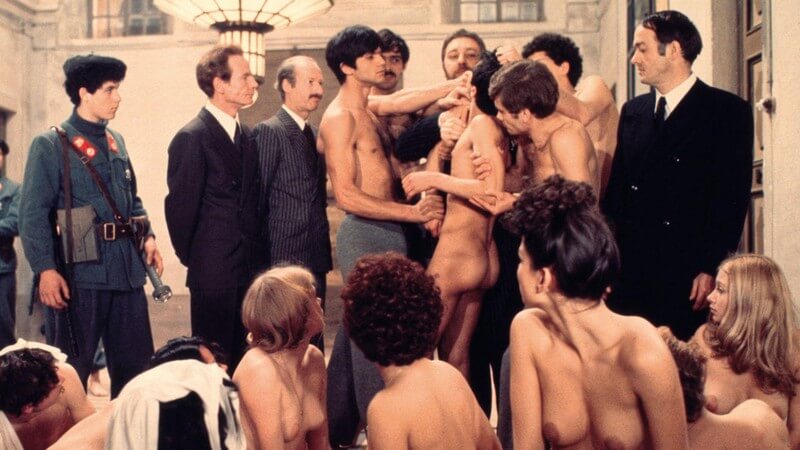
So what else has Pasolini prepared for us, what images will he want to “regale us with” and what boundaries will he cross? All the worst. The work of the Italian director is the quintessence of criticism of the lack of humanity. And the fact that these boundaries are crossed is evidenced, firstly, by the fact that the film is still banned in many countries, and secondly, by the very death of Pasolini, who was brutally murdered before the premiere of Salò.
Due to the fact that I consider Pasolini’s work to be an outstanding film, I am not going to spoil all the torture scenes that occur in it, I can only assure you that there are plenty of them, and human imagination knows no bounds. Of course, this is not a gore movie, but the amount of sadism here is enormous.
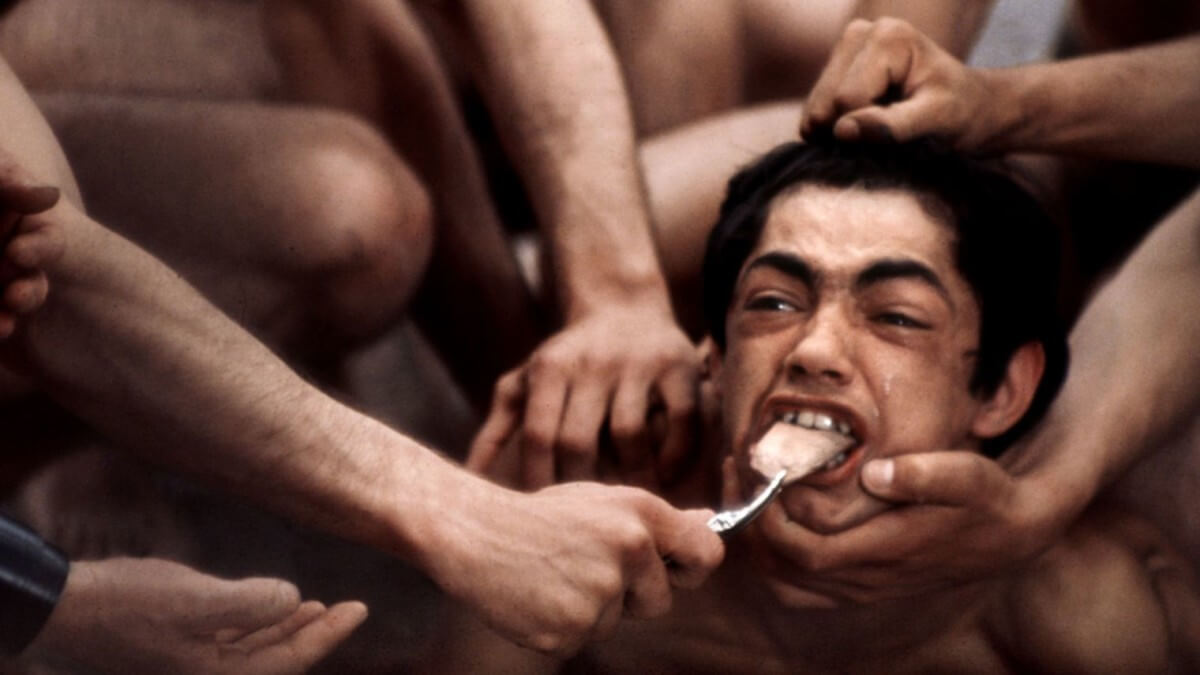
I would like to focus on the scenes where there is nudity, and there is nudity almost all the time. I have already mentioned the scene where the fascists carefully examine their victims. Another moment in which we encounter nudity is, for example, the meal scene, during which naked female victims of fascists serve them at the table. They almost become objects. But the service doesn’t end there – one of the women is anally raped. Let’s not forget, however, that for the perpetrators, sex is fun here, and since homosexual acts cannot be missing, there is a sexual intercourse between the perpetrator of the raped woman and the president. Nudity in the film does not concern only the victims, except that we can read it in quite different ways. Because the torturers undress of their own free will, for pleasure and fun, unlike the victims, who are humiliated by nudity and sexual acts. However, the soulless behavior of tyrants continues. Another very significant scene in which nudity plays a major role is the one in which the victims have collars around their necks – leashes are attached to them, on which the victims are led, to the delight of the fascists. If you think already at this stage that complete dehumanization is taking place, you are wrong. This is still not the end of physical and mental torture.
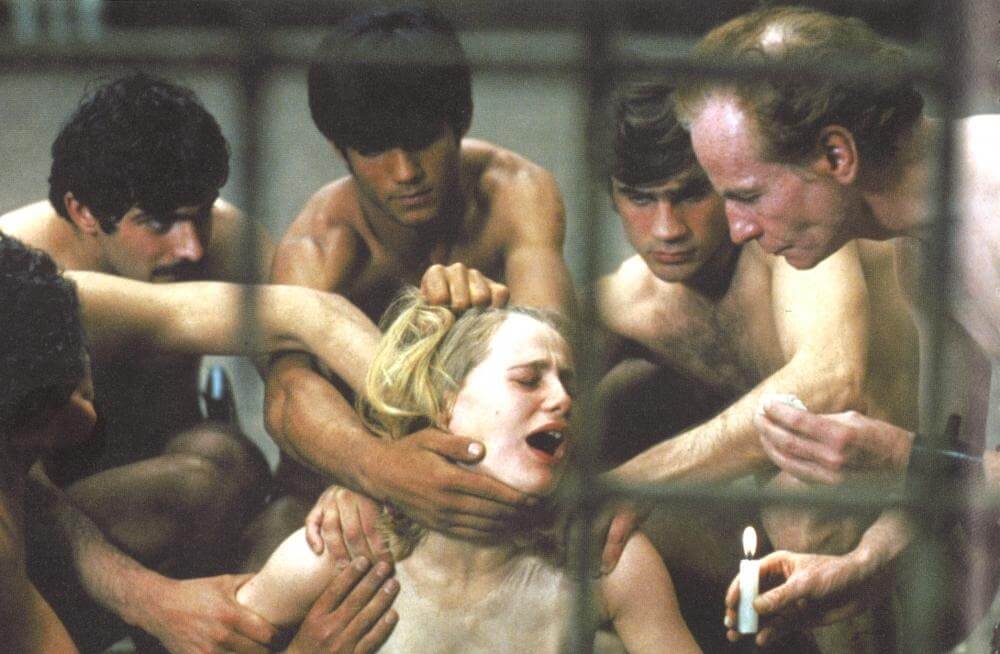
Another important scene in my opinion is the wedding scene of the victims, a boy and a girl. They are exceptionally dressed in wedding clothes in this scene, while the rest are naked with flowers in their hands. These flowers bluntly emphasize the innocence of people sentenced to this hell. During the wedding, one of the tormentors gropes and kisses passionately the boys of his choice, who cannot object to it. The “spouse” couple, on the other hand, is forced to have sex with each other in front of the others, and this activity turns into an orgy, of course.

As has already been said, nudity in Pasolini’s film is present almost constantly, but it is completely justified nudity and I can’t imagine this brilliant film being shot any other way.
Unlike many filmmakers, for whom nudity does not make any sense – it is only intended to arouse unnecessary desire and excitement or disgust in the viewer (unfortunately, this is a common practice in cinema) – Pasolini creates a story, in which this nakedness is a symbol of human innocence. Naked victims are helpless and vulnerable. Their lives depend on the humor of their tormentors, who are like emotionless beasts. Salò, or the 120 days of Sodom, is a story of double dehumanization. Because the victims are treated inhumanely, and the fascists are deprived of humanity, feeling power over boys and girls who do not have their own voice.

